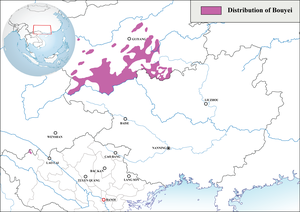
Back Bouyei (Sproch) BAR Bouyieg Breton Buó-ĭ-ngṳ̄ CDO Bouyei (Sprache) German Idioma buyei Spanish Bui keel Estonian Bouyei French Linguas buyi Galician Buyei bhasa HIF プイ語 Japanese
| Bouyei | |
|---|---|
| Giay (Yay) | |
| Haausqyaix | |
| Native to | China (Guizhou, Yunnan and Sichuan Provinces) Vietnam |
| Ethnicity | Bouyei, Giay |
Native speakers | 2.7 million (2000 census)[1] |
| Latin, Sawndip | |
| Language codes | |
| ISO 639-3 | pcc |
| Glottolog | bouy1240 |
 Geographic distribution of Bouyei language | |
The Bouyei language (autonym: Haausqyaix, also spelled Buyi, Buyei or Puyi;[2] Chinese: 布依语; pinyin: Bùyīyǔ; Vietnamese: tiếng Bố Y or tiếng Giáy) is a language spoken by the Bouyei ethnic group[3] of Southern Guizhou Province, China. Classified as a member of the Northern Tai group in the Tai language branch of the Tai–Kadai language family, the language has over 2.5 million native speakers and is also used by the Giay people (Vietnamese: Giáy) in some parts of Vietnam. There are native speakers living in France or the United States as well, which emigrated from China or Vietnam. About 98% of the native speakers are in China.[2]
Bouyei's characteristics are similar to the other members of its language branch. It is generally monosyllabic and word order and particles are the main forms of grammar. Bouyei's syllable initials match up closely to the other Northern Tai languages, with relatively fast simplification and merging. Bouyei sentences can be shown to contain many different levels of phrasing.
The contemporary Bouyei script was developed after the abandonment of the Bouyei-Zhuang Script Alliance Policy in 1981 and was designed from 1981 to 1985. It is focused and phonologically representative and takes the Wangmo County dialect as its foundation.
- ^ Bouyei at Ethnologue (18th ed., 2015) (subscription required)
- ^ a b "Bouyei". Ethnologue.
- ^ "Buyei Ethnic Group". Unique China Tours. Archived from the original on 2011-07-24.